How does a human settlement become more than land with houses on it? How do people start to merge the story of their lives and relationship with the ground they live on? One of the ways humans mark ground with stories is by making graves.
Farming families started digging graveyards in the Bolingbrook area almost as soon as they settled here. (People died early and often back then.) A cemetery on Boughton, near Pinecrest, has graves dating, at least from what I could see, to the 1840s. They’re surrounded by a suburb where not much dates before 1959. Below, Florentine Godfrey, who died October 1, 1876.
But nowadays, graveyards aren’t the only resting place for the dead. Several families in my church keep the ashes of their loved ones in urns at home. You’ve probably seen more hand-made memorials along highways and major roads than you can count. My dad and his siblings “sprinkled” my grandfather in some woods on the side of a hill in southern Indiana, back in 2005.
The park near our house, where I walk our dog most days, is full of “memorial trees.” Each has a metal plaque on a concrete slab at its foot, and is part of a Memorial Tree Program sponsored by the Bolingbrook Park District. For $325, you can dedicate a tree to a loved one, a special event, or an organization. So far, I’ve only seen trees dedicated to people who have died.
Maybe a park seems more friendly than a graveyard. You can imagine your loved one watching bicycles whoosh by, hearing dogs barking at each other, or feeling kids’ feet pounding the soccer fields… instead of watching hearses roll by, hearing pastors say sad words, or feeling ground get dug up and replaced, dug up and replaced, dug up and replaced. It’s a lot cheaper, too.
How old was Megan when she died? Did she die suddenly? Was there an illness or an accident? Did her family choose this park for her memorial tree because they lived in the neighboring subdivisions? Do they still?
These plaques feel full, even when all you see is a name and a year.
Two women. A year apart. Two trees next to one another. Were they sisters? A mother and daughter? This one always breaks my heart.
So, our local park doubles as a kind of graveyard. There aren’t any remains involved (unless a family brings them by cover of night, I suppose), but just the same. These trees aren’t just trees. There’s a story, a family, and a life behind each one. Our park isn’t just about sports, property values, or flood control, the things I imagine it was intended for. It’s also become a place to remember the dead.
Jack has two trees (and two plaques) right next to each other, alongside a playground. I picture a grandfatherly man, who enjoyed children.
See that slender trunk? All those memorial trees are still young. This park is only twenty years old. That’s a man-made pond, behind Jack’s tree. You can see giant outdoor lights in the background that illuminate kids’ soccer games and produce some ferocious light pollution on summer nights. The whole park is surrounded by subdivisions and town homes. It’s a purely manufactured place. It could be a park in almost any suburb in the northern U.S.
Still, the memorial trees stake a claim: people live here, people die here. Particular people, with names, stories, and people they love. No matter what, a piece of land starts to tell a story about the people who have lived there. And died there. Whether it’s 1876 or 2006.
Rest in peace, Florentine, Lucille, Megan, Emily, Kelsey, and Jack.
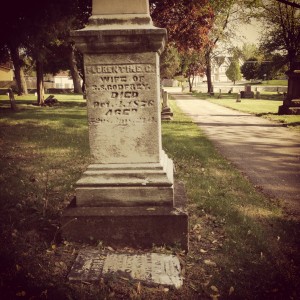
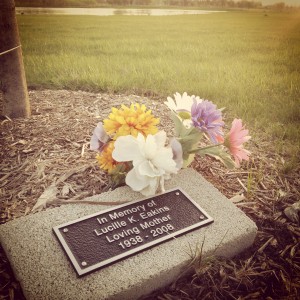
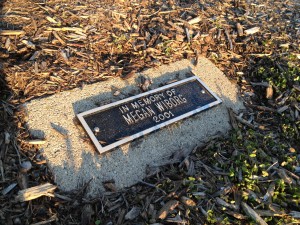
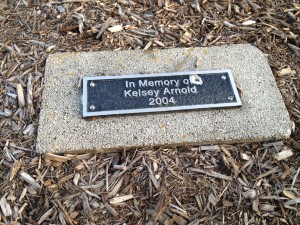
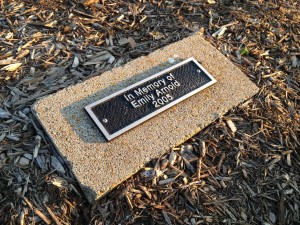
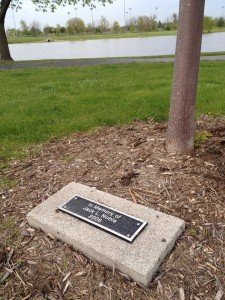



[…] park near our house is full of memorial trees, and now, we also have a memorial tire […]